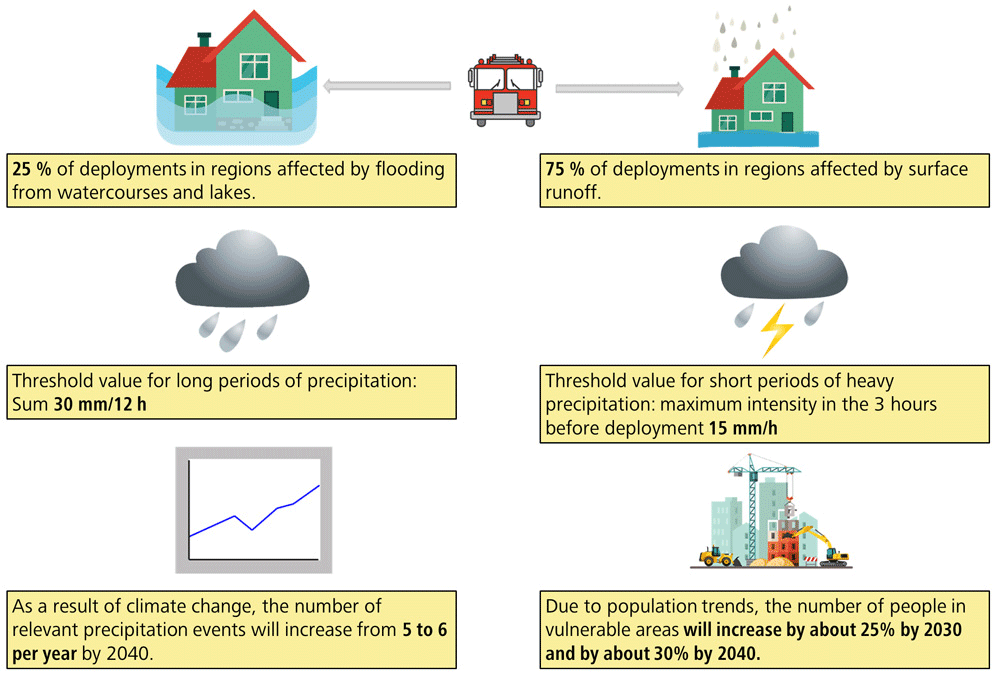As a result of climate change, the frequency and intensity of weather extremes are on the rise. An increase in heavy precipitation can already be seen in many regions today. This will affect the scope of damage. The frequency and scope of intervention needed by civil protection forces will also increase.

The challenge of climate change for civil protection has already been an issue for several years. However, the impacts and the ensuing measures have so far only been generally identified.
The study “Starkniederschläge und Einsatzplanung von Schutz und Rettung Zürich” (Heavy precipitation and deployment planning of the Zurich protection and rescue services) was initiated as part of the focus on the issue of climate change and civil protection. It outlines the effects of an increase in heavy precipitation on deployments of the Zurich protection and rescue Services.
Goals
The study has two parts with clearly defined goals:
- Part 1: Analysis of the dependency of the deployments on precipitation:
Identification of critical precipitation thresholds to trigger a deployment. - Part 2: Estimation of qualitative changes in future deployments over the next 20 years.
As this is a pilot study which is intended to serve as a basis for further analyses, the method used is clearly documented.
Content
The analyses show that there is a quantitative correlation between precipitation and the number of deployments of the Zurich protection and rescue services. A distinction must be made here between short periods of heavy precipitation and long periods of precipitation. For short periods of heavy precipitation, a threshold value of 15 mm was identified for the maximum precipitation intensity in the three hours before the deployment. For long periods of precipitation, the threshold value for the 12-hour sum before deployment is 30 mm. This makes it possible to detect events relevant to the Zurich protection and rescue services with a higher number of deployments (> 50 deployments within six hours).
Around 75% of the deployments have taken place in areas potentially at risk from surface runoff. This stands in contrast to approximately 25% of deployments that could be affected by flooding from watercourses or lakes. These two hazard scenarios can also overlap.
The study shows that in the near future (approx. 20 years), the development of residential areas is a greater challenge for Zurich protection and rescue services than climate change. In the second half of the century, however, the impacts of climate change will clearly gain in importance.
Highlights
- The study highlights the major importance of surface runoff.
- The findings of the study serve as a basis for the Zurich protection and rescue services to better manage staffing of the control centre in the event of imminent storms.
- Based on the findings of the study, qualitative statements can be made about the future requirements for Zurich protection and rescue services associated with climate change and the development of residential areas.
- This study has developed a method which makes it possible to quantitatively analyse the correlations between precipitation and the deployments of the Zurich protection and rescue services. This method can be applied to other regions or other processes (e. g. heat).
- The participatory approach was very beneficial in the development of the study. Various perspectives have been taken into account through the involvement of stakeholders from the federal government, canton, city, insurance companies and the scientific community
Partners
The study was conducted by the geoscientific office geo7 AG under the direction of the Federal Office for Civil Protection (FOCP). The study was only possible thanks to the high-quality data provided by the Zurich protection and rescue services, MeteoSchweiz and the cantonal authorities of the canton of Zurich.
The most important partners:
- City of Zurich, protection and rescue services
- City of Zurich, security department and city police
- Canton of Zurich, Office for Waste, Water, Energy and Air WWEA
- Gebäudeversicherung Zürich GVZ (Zurich Building Insurance)
- Federal Office of Meteorology and Climatology MeteoSchweiz
- National Centre for Climate Services NCCS
- Federal Office for the Environment FOEN
- Swiss Federal Institute of Technology in Zurich ETH Zurich
- Swiss Federal Institute for Forest, Snow and Landscape Research WSL
Last modification 07.07.2022







